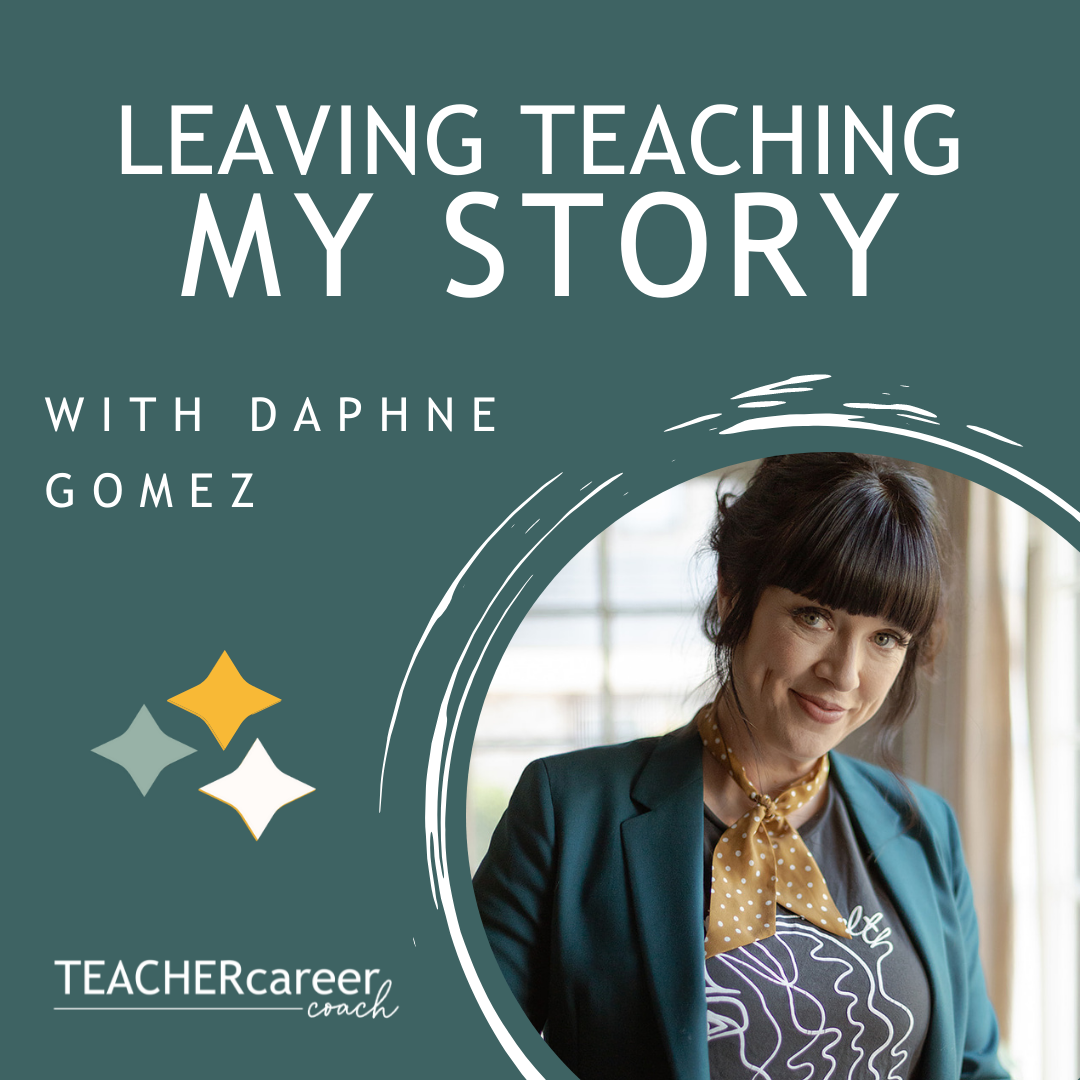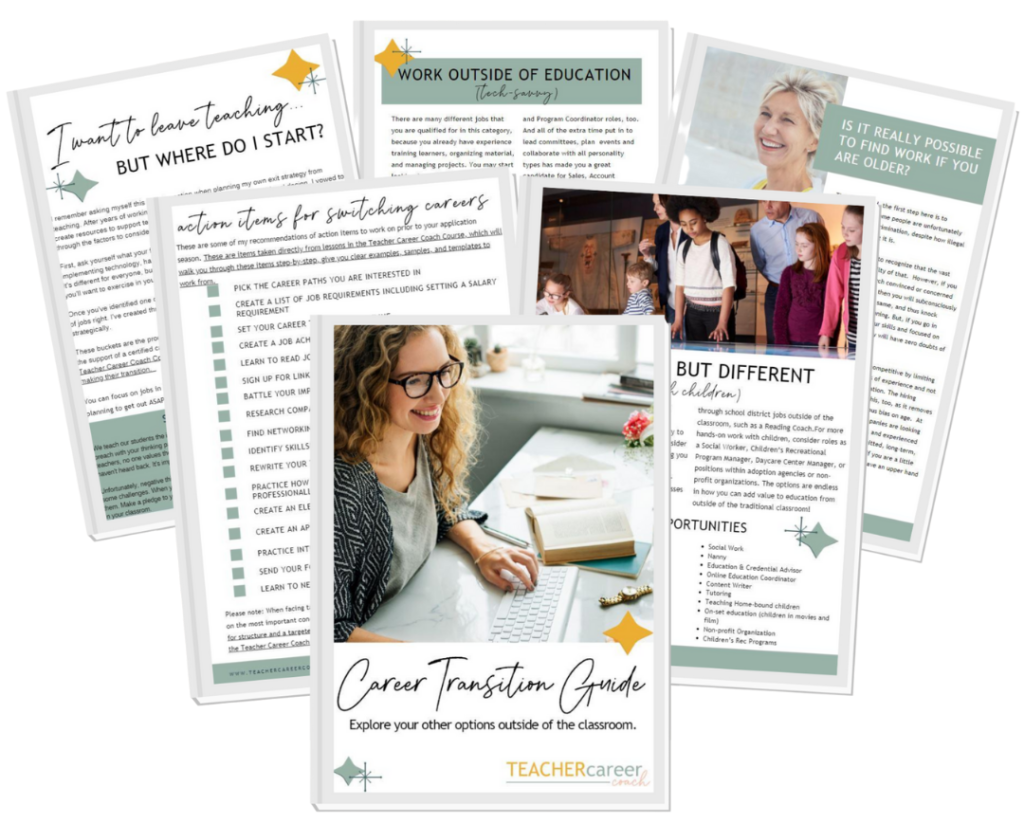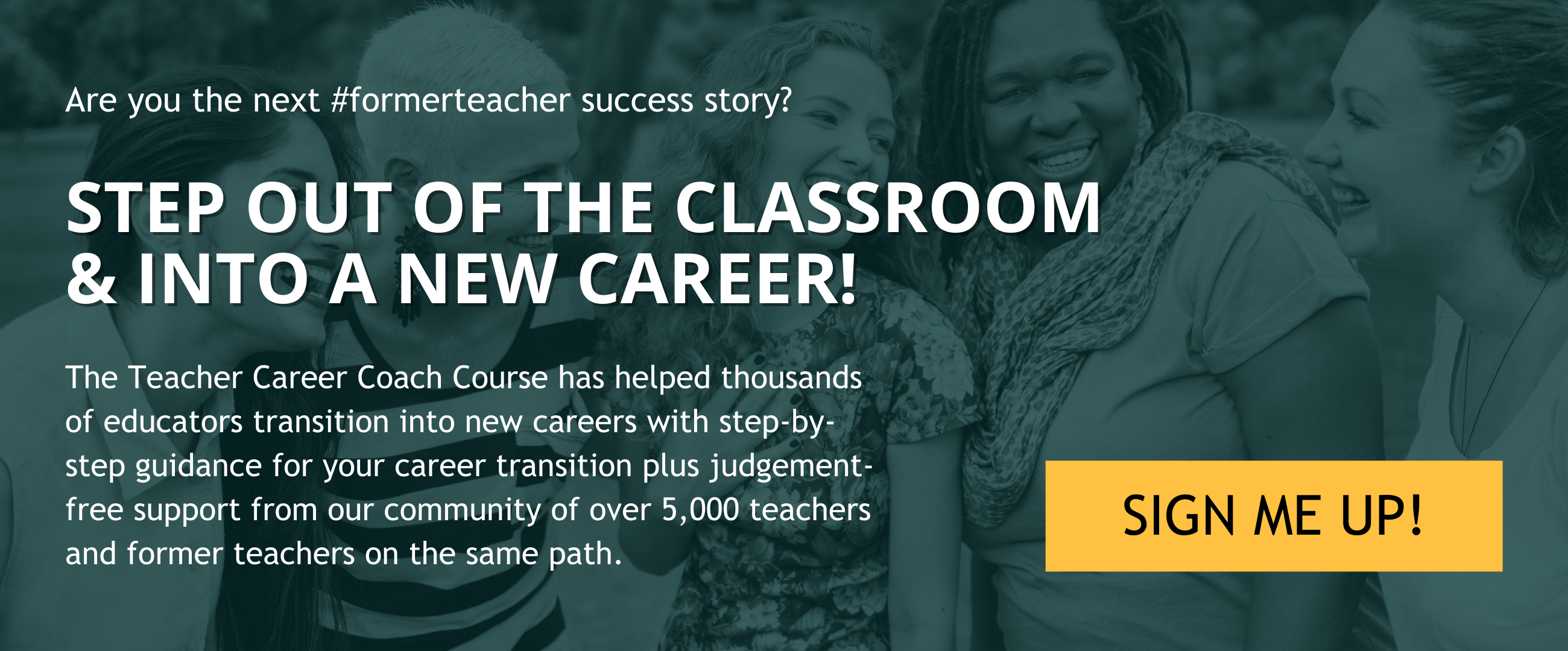I’ve been asked to share my teacher career transition story time and time again, so I lay it all out in this episode of the Teacher Career Coach podcast. Follow along as I share the struggles I faced as I made this difficult decision and the reasons why I ultimately took the leap. I dive into everything from starting my first side hustle to transitioning into educational consulting and instructional design roles. Knowing this transition is full of highs and lows, I talk about the mindset shifts I had to make all along the way. In short, this episode is full of my biggest tips and takeaways from my journey. So, whether you’re considering leaving yourself and looking for inspiration or simply are curious, I’m excited to share this one with you.
Listen to the episode in the podcast player below, or find it on Apple Podcast or Spotify.
Recap and BIG Ideas:
- If you’re unhappy in the classroom, consider if switching grade levels or school districts would help.
- It’s okay to put your needs and well-being first. You can always go back to the classroom after taking some time off.
- There are many highs and lows of the job search, but it only takes one “yes” to change everything.
- Educational consulting and instructional design positions offer a smooth career transition for many teachers.
- There are many different career trajectories for teachers looking for options outside of the classroom.
- Generating multiple revenue streams is a great way to gain a sense of financial freedom where you don’t feel stuck in any one job.
- You don’t have to have everything figured out. You just have to be committed to the journey and
- The change we’re craving is often waiting outside our comfort zone.
I kept waiting for the first-year jitters to go away. Instead, they continued to get worse.
Daphne: Many people have asked me to share my story about why I left teaching and what I’ve been doing since then. I started teaching as a fifth-grade teacher at a low-income school district in my late 20s. I was passionate about giving back to the community and thought I could make a valuable impact by helping students appreciate education.
That passion remained for those first few years of teaching. However, I had this feeling deep down inside that I was drowning or struggling. It was strange because I’d never felt that way with any previous job I’d had. I found myself constantly questioning whether or not I had pursued the right career path. That was scary for me because I had invested so much time and energy into becoming a teacher. I had earned the certificates and credentials I needed, so I assumed that meant I’d feel as though I’d found my calling and forever career. Ultimately, I guess I just thought that I would love it.
Once those doubts started creeping in, I chalked it up as the jitters. The first-year jitters became the second-year jitters. I was passionate about the notion of helping kids, so I figured the puzzle pieces would eventually fall into place.
After those few first years of struggling, I left that school to move down to Los Angeles and take a position in a different district. I thought that would be the answer and that I would find my groove and footing as a teacher. I was working with a completely different demographic than before. These students were deemed gifted and talented and came from wealthier neighborhoods in Los Angeles. Regardless, I quickly found issues in that district as well.
That very last year was by far the worst I’ve ever had. Truthfully, it had nothing to do with the students. I felt completely burned out by the expectations, lack of autonomy, and an extremely toxic work environment in that second school. There was a lot of pressure from the administration–and parents–to do things outside of expected teacher duties. I feel a bit dramatic when I say that there was some bullying going on from parents. I caught wind of negative social media postings about me from parents and gossip about me from parents and administration.
It was just such an unhealthy and unprofessional environment. I went from feeling disrespected to just broken and depressed. My year in that school district left me feeling mentally and physically unwell to the point where I was visiting the doctor for stress-related illnesses.
To this day, I feel overdramatic when I explain what that situation was like for me, and I’m always quick to try and defend myself and my decision to leave, laying out every single detail that led to that decision. I’ve come to learn this is common if you’re coming from a toxic work environment. Feeling such stress daily over a prolonged period of time really negatively impacts your mind and body. The doctors continuously pointed toward stress as the culprit of my health issues. And I knew exactly what that source of stress was. By the end of the school year, I was breaking down in tears on my way to school. I remember putting on makeup once I got there in hopes of covering up the truth.
Ultimately, I realized I was so burnt out and stressed that I just needed a break. I needed to take a year off from the classroom. By the time that school year came to an end, I had come to terms with the fact that it was time for me to reinvent myself. I knew I could always go back to the classroom a year later if I wanted to. I knew I wasn’t all the way in with the job and knew I needed to focus on my well-being.
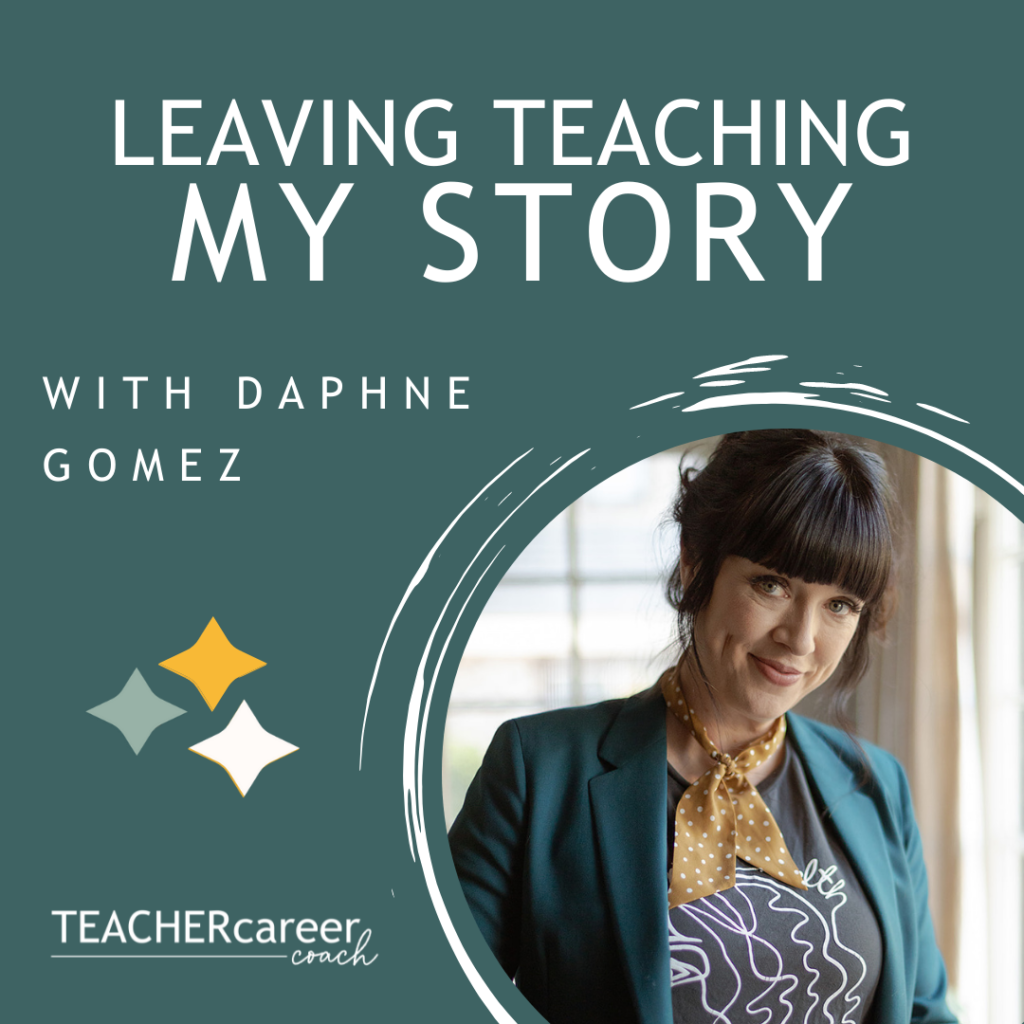
The highs and lows of searching for jobs outside of the classroom.
I started looking for jobs that hire teachers. Like many of you know, there weren’t a lot of resources out there. I think the pandemic has brought a little more compassion and empathy towards teachers considering other careers. Back in 2017, there weren’t many people willing to talk about that transition as a possibility. I was facing pushback from people saying, “But you’re a great teacher,” and, “You can’t not teach.”
It was like I’d signed this invisible contract tying me to teaching for the rest of my life. So, I had to set some clear and firm boundaries around understanding that I needed a break and that I might never go back. I knew I had to keep moving forward and take the appropriate steps to figure out who and what I wanted to be. Ultimately, I just wanted happiness. That was the most important thing for me, and I needed a career that would add to that happiness. Honestly, I was scared by the thought of teaching for another five or ten years. That’s not how your career is supposed to make you feel. If your career is making you feel that way, it’s important to examine that feeling and what it is that you can do to make a change.
I finally realized I needed to figure out what I needed to do to be happy. I did consider interviewing at other school districts, but because I’d already worked at two completely different ones, I felt like the common denominator might have just been teaching wasn’t a great fit for me. I started to see it as an opportunity for me to do something scary and get outside of my comfort zone.
Don’t get me wrong; I had some really low points as I applied to and interviewed for new positions. One time I received four rejection letters in one day. I’ll never forget laying on the couch bawling my eyes out, feeling like I was never going to get another job.
For about three months, I was aggressively putting out resumes and not getting many callbacks. The interviews I went on weren’t always great. Sometimes I was told I wasn’t qualified for the position, and that’s when I started to realize there’s a difference between not being qualified for one job and not being qualified for all jobs. That realization helped push me forward on my new path.
The one “yes” that changed everything.
Truthfully, it was one of the most emotionally draining times of my life, but it only took one yes for everything to change. For me, that was a role as an educational consultant. I went into the phone interview expecting it to be a very low-paying job or that there would be some hoops to jump through before I actually got paid because I’d run into a few jobs that preyed on teachers like that.
I was really confident in my job interview and, because of my experience in education, I almost felt like I was interviewing them. When they started to tell me about the salary, I realized this was my next move. I really wanted the job. A few weeks later, they offered me the position.
What exactly is educational consulting?
I’m often asked what precisely educational consulting is. It’s one of the vaguest position titles out there, but consulting and consultant just means that you’re an expert in something. In this case, it’s an expertise in education. Now, the role will look different from company to company, but, most of the time, it involves doing professional development for schools and districts on behalf of a company or as an independent freelancer, which means they have a specific curriculum they run trainings on.
Sometimes educational consultants work with a company looking for a teacher’s perspective on how a product should be created. They’ll ask you to identify flaws in a product, offering changes teachers might desire even before the product is made. Sometimes they offer advice about how to market a product to educators. So there’s a few different things the position could mean.
I’ve noticed with educational consulting that many jobs are independent contractor positions or part-time positions. That’s a caveat I always like to mention. Now, my role was actually a full-time independent contractor position, which is scary because there weren’t any benefits packages with insurance or retirement options. However, that was a risk I was willing to take. I weighed out the salary without these benefits to make sure that it was a good fit for me and that the risks were worth the rewards.
In this role, I get to be my own boss, create my own schedule, and have a lot more free time to spend creating even more revenue sources. The particular role I have involved public speaking at events and national conferences, and working with different school districts. There’s also an element working on a higher level with the school districts to create the training program. Then I actually train the teachers and offer free professional development for them on this specific product.
There was definitely a learning curve, especially when it came to speaking in front of large audiences. But there was an unexpected perk to speaking at those national conferences. I was able to travel to different states on the company dime. While it was a lot of work to prepare for those conferences, it was almost like having a paid vacation. In fact, I started to feel guilty that I was happy. I kept thinking back on school districts that I had left, or teachers that I had worked with who I kept in touch with were looking for similar positions outside of the classroom.
Educational consulting opened the doors for me to create additional revenue streams.
Between my former collegues and teachers at the conferences, I was always asked about my tranistion from classroom taecher to this role. That’s when the idea for Teacher Career Coach started developing in the back of my mind. I knew that there was a need for teachers to understand that there were career options for them outside of the classroom, and that there was a natural path as an educational consultant they could easily transition into.
I started to meet a lot of former teachers, which opened my eyes to this entire network I didn’t know existed. It started to show me all the opportunities out there and the different career trajectories that teachers could take outside of the classroom. Many of my educational consultant colleagues were former teachers as well. I learned what their paths had been like and saw what different roles they moved into overtime.
I truly loved my role as an educational consultant and how it allowed me to take so much time back. If I didn’t have any trainings or conferences scheduled, I would have way more downtime than I ever had when teaching in the classroom. It was during that time that I really stepped up my game and started my first side hustle, the Kitten Approved Curriculum store on Teachers Pay Teachers. Sure, my contractor role didn’t give me benefits, but I figured if I could make an extra few hundred dollars a month, I could put it into a SEP IRA for retirement. I put all of my Teachers Pay Peachers revenue into that retirement account.
My experience as an instructional designer (and why I went back to educational consulting).
At the same time, as I mentioned, I was connecting with a lot of former teachers. That opened the door for me to work as an instructional designer at a well-known company. About a year or two after one of my consulting colleagues moved to that company, she reached out to me regarding the new opportunity. I had already created this digital course Teacher Career Coach, and she knew that I had experience creating plenty of online curriculum materials. She knew I had a lot of skills with creating eLearning resources for my side business, so she thought I’d be a perfect fit for an upcoming role as an instructional designer at the company that she worked for.
I was back to weighing the pros and cons of a new position. At the end of the day, learning technology tools and best practices for creating learning materials amongst many career professionals felt like a step in the right direction for me. I left my role as an educational consultant to take that opportunity as an instructional designer.
In my role as an instructional designer, I was tasked with creating an eLearning platform for teachers to learn how to use and implement a specific product. It felt like the perfect role for me because it involved skills that were already on my radar. I wanted to learn best practices and graphic design, stay up to date with user experience and make sure everything I created for my own business was simplified and easy for people to access.
More specifically, my job as I was creating this eLearning platform for teachers was to develop the resources to help them learn how to implement the technology product in their classroom. I needed to cover the best practices on why you would use this and how you would set it up according to various pedagogies. I also offered certification training for any teachers wanting to show their proficiency in said product. Now, if you want to hear more specific details about instructional design, make sure you listen to episode nine of the podcast dedicated to explaining why teachers make great instructional designers.
It was while I was working for this company that Teacher Career Coach really started taking off. I went from having 2,000 people to 20,000 people following my social media account, sending me DMS with questions, sharing their stories, and asking for advice. Now, my instructional design role was a classic 9-5 position. Once again, I was testing to find myself feeling burned out. Eventually, I came to a crossroads where I had to decide whether I was going to shut down my Teacher Career Coach project or leave the 9-5 job to focus on running the Teacher Career Coach full time.
If you’ve been following me for any amount of time, you know that I do everything out of an abundance of caution. I don’t want anybody to leave their position for a side hustle unless they’ve been able to watch the data for long enough to make sure that they know the numbers and feel comfortable that it’s going to give them the income they need to live comfortably. Luckily, right as I was reaching a high level of burnout, the people I worked as an educational consultant for reached back out to me to see if I wanted my contract-based position back. It was perfect timing.
I was willing to take a slight dip in salary for more free-time to follow my passion for building the Teacher Career Coach. So I left the instructional design position and went back to my role in educational consulting. As of right now in February 2021, I’m still working as an educational consultant in addition to Teacher Career Coach. It’s an excellent fit for me right now, and I don’t have to give up on growing this platform.
The biggest lessons I learned along the way including why you don’t have to have it all figured out to get started.
Now, I learned so many lessons throughout this entire career transition process. One of my biggest takeaways was that you can figure out hard things. I had extremely low self-esteem when I was in my last year of teaching. Still, I persisted and navigated everything from contributing to retirement and setting up health insurance to establish a business entity. Often, we talk ourselves out of trying to figure things out because we don’t believe that we’re capable of achieving the result we desire. People avoid starting a business or a side hustle because they don’t want to figure out the taxes or whatever. Honestly, that’s just code for, “I don’t believe that I can make enough money to justify investing time into figuring out the taxes,” or whatever it may be for you.
The bottom line is you don’t have to have it all figured out. You just have to believe in yourself and take it one step at a time. I don’t regret taking any position, whether it was teaching or instructional design, because I’ve learned from every part of this journey. Looking back on my years in the classroom, I know that I achieved my goal of positively impacting students. My time as a teacher also helped me better understand how I can support teachers from outside of the classroom. In fact, my teaching career was the stepping stone to get me to where I am today.
Things change, and that’s okay. Over a year ago, I was really excited about an instructional design position because I wanted to eventually become a director of professional development or a manager of customer learning. My plans and ambitions changed, and yours might too. Eventually, you might want to pivot.
A big part of these pivots is getting comfortable with failure. Rejection is redirection, and I’ve gotten so much more comfortable with failing because I know it’s taken quite a few failures to get me to where I am today. Since I’ve worked in a few different roles, from teaching to educational consulting and instructional design, I have more clarity on what types of roles I would want in the future. Every experience I’ve had has taught me a lot about myself and what I want. I know that I like working with a variety of people and like working independently. I also know that I need autonomy to be happy. I’ve been in positions where I’ve felt micromanaged, and I just can’t thrive in those situations. I also know that I like project planning and being creative. I enjoy setting and achieving long-term goals. I’m organized and prefer working strategically and efficiently. So moving forward, I have a better understanding of what would make me happy in a position.
Additionally, because I worked on creating side income, I’m no longer financially dependent on any single role. I have a diversified income stream which helps me feel a sense of financial freedom. I’m no longer financially backed into a corner like I was as a teacher. That’s why I urge so many of you to think about creating a side business, especially if you’re thinking of leaving the classroom. Even the smallest amount of income brought a new confidence and sense of financial security that allowed me to pursue whatever made me happy.
A final word of advice for anyone just starting on this journey.
Now, you might be in the beginning stages of this transition, and all you might need right now is to consider switching districts or grade levels. But maybe that’s not enough. At the end of the day, you are the only person who’s going to know what that right decision is for you. The most important thing is that if you are unhappy, you start to really figure out what it is that’s making you unhappy. From there, you can start making changes that will make you feel better, happier, and more fulfilled.
If you’re unhappy, chances are it’s going to take doing something different and perhaps uncomfortable to reclaim that happiness. Maybe it’s changing your pedagogy or prioritizing self-care. Maybe it’s saying no more often and feeling more comfortable walking away from tasks that don’t align with your priorities. It might be switching schools or districts and making that uncomfortable decision to walk away from an administrator or a toxic work environment. Hey, it might even involve showing up on social media as you establish a side hustle to create extra income.
Yes, these may be things that make you a little uncomfortable but will end up helping you find that sense of purpose and happiness you’ve been missing. You can take so many different directions, but once you pick the one you want to take, the most important thing is to commit to taking that first step toward change. Follow your heart and trust your gut. From there, you can work towards bettering your life.
Where to start
If you’re just beginning to think about leaving teaching, brainstorming other options is a great place to start. But if you’re like many others, teaching was your only plan—there never was a Plan B. You might feel at a loss when it comes to figuring out what alternatives are out there.
Start with our free quiz, below, to get alternative job options for careers that really do hire teachers!
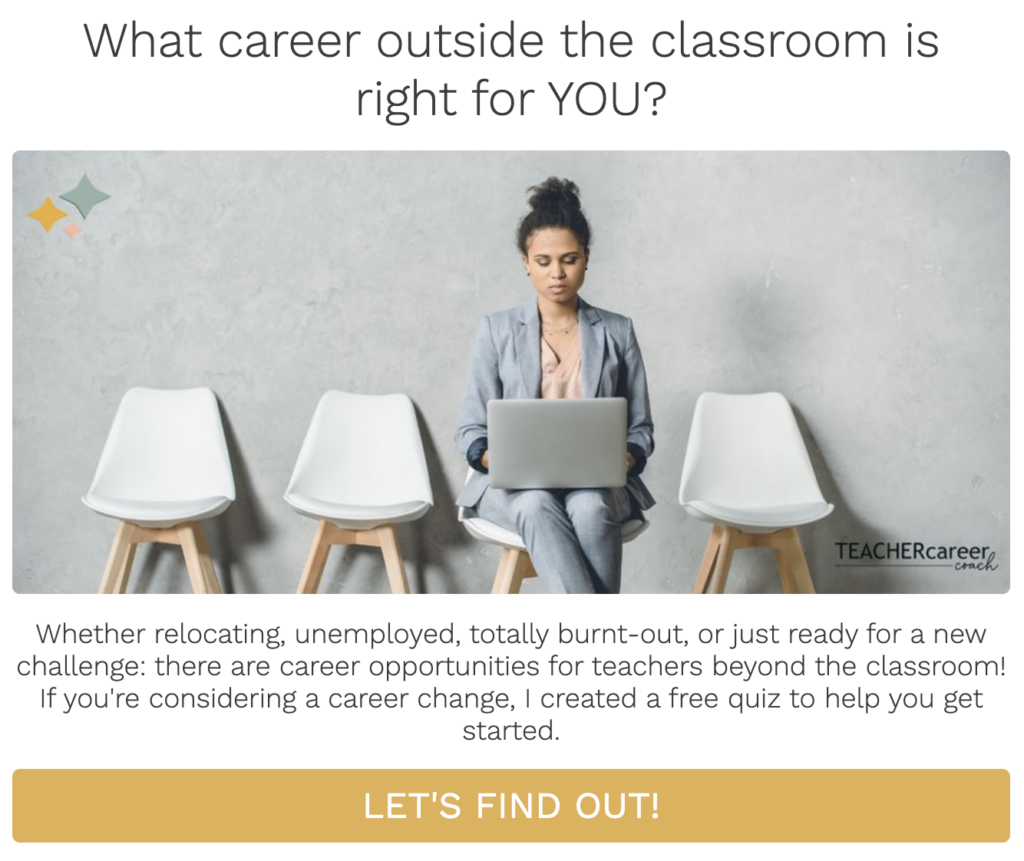
Taking the First Steps to a New Career
If you’ve already taken our quiz, it may be time for the next steps. I want to help you get some clarity in the options available to you. To know EXACTLY what you need to do (and not do) in order to get your foot in the door.
One of the biggest mistakes that I see teachers make is that they try to navigate this process alone. Often, they put off “researching” until the very last minute. Which sets them up for a very stressful application season—trying to juggle teaching, figuring out a resume, researching jobs, and hoping to nail down some interviews before signing next year’s contract.
You don’t have to do this on your own.
If you are considering a career change from teaching, I have a resource that can help you today. With the help of an HR expert with over 10 years of experience, I’ve created a guide to support you in the early stages of your transition out of the classroom.
In the Career Transition Guide, I’ll walk you through the factors to consider and answer those first-step planning questions including:
- A compiled list of over 40 careers that teachers can transition into
- An overview of how to read job descriptions
- How to evaluate the risk of leaving a full-time teaching job for the unknown
- Example translations from classroom-to-corporate resumes
- A checklist of everything you’ll need to do for your career transition (so you know you aren’t missing anything!)
- and more…
Take the first steps on your path to a new career now for only $19 $9!
